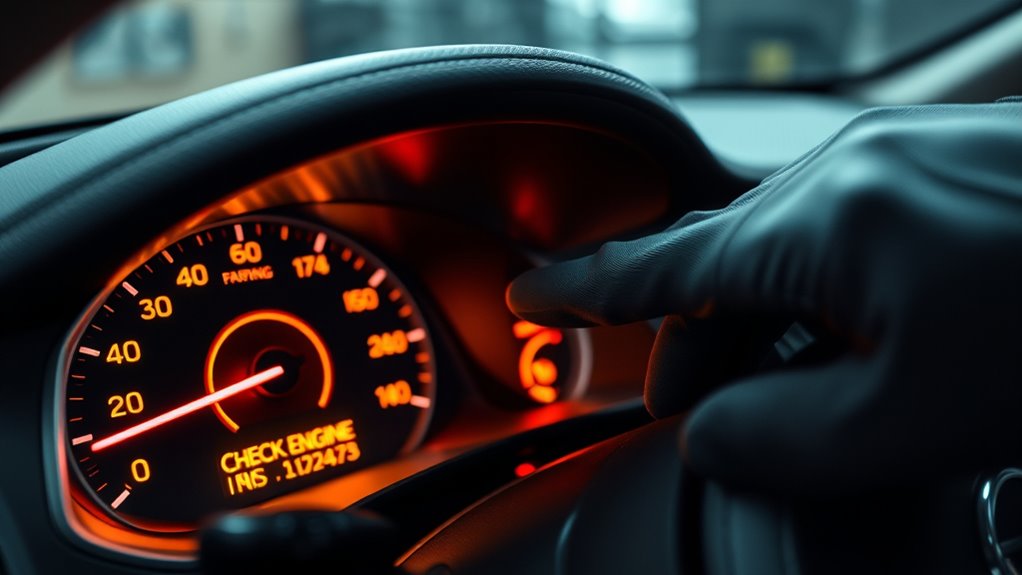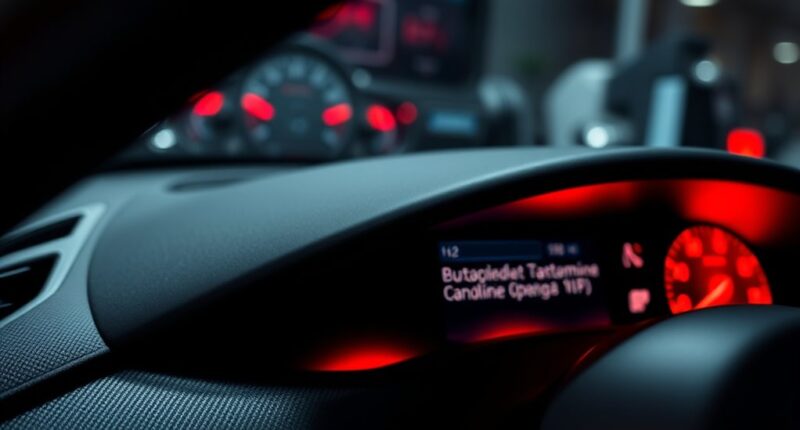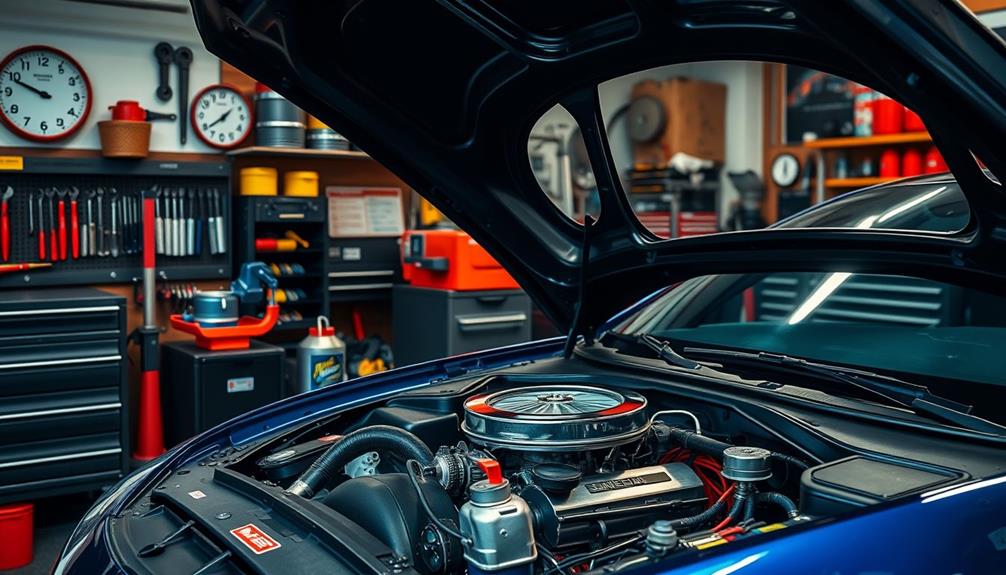If your check engine light stays on, it’s often due to sensor issues, emission system faults, or engine problems that need attention. Faulty sensors like oxygen or airflow sensors can cause false alerts or performance issues, while emission system leaks or failures can trigger the light and harm your vehicle’s efficiency. To diagnose it like a pro, you’ll need to use an OBD-II scanner to check error codes. Keep exploring to learn more about pinpointing and fixing these issues quickly.
Key Takeaways
- The check engine light stays on due to sensor malfunctions or emission system issues that trigger a fault code.
- Common causes include faulty oxygen sensors, mass airflow sensors, or leaks in the emission control system.
- Use an OBD-II scanner to read error codes, pinpointing the specific sensor or component needing attention.
- Address the underlying problem promptly to prevent further damage and ensure compliance with emissions standards.
- Regular diagnostics and maintenance help keep the check engine light off and your vehicle running efficiently.

When your check engine light comes on, it’s a clear signal that your vehicle has detected a potential issue that needs attention. One common cause is sensor issues, which can disrupt the vehicle’s ability to monitor various systems. Your car relies on a network of sensors to keep track of engine performance, emissions, and safety features. If a sensor malfunctions or gives false readings, the onboard computer will trigger the check engine light to alert you. These sensors include oxygen sensors, mass airflow sensors, and temperature sensors, all vital for maintaining proper engine function and controlling emissions. When sensor issues arise, your car might still run, but it’s no longer operating as efficiently or cleanly as it should. This can lead to increased emissions and fuel consumption, and in some cases, could cause damage to other components if left unaddressed.
The emission control system is another key factor behind a persistent check engine light. Modern vehicles are equipped with complex emission control mechanisms designed to reduce harmful pollutants released into the environment. Components like the catalytic converter, evaporative emissions system, and exhaust gas recirculation (EGR) valves work together to keep emissions within legal limits. If any part of this system malfunctions—say, a leak in the evaporative emissions system or a failing catalytic converter—the vehicle’s computer detects the issue and turns on the check engine light. Often, these problems are subtle at first, but ignoring them can lead to more severe damage, higher emissions, and even legal issues if your vehicle fails inspection. That’s why it’s important to pay attention to the light and get a proper diagnosis.
Diagnosing sensor issues and emission control problems isn’t something you should ignore. Using an OBD-II scanner allows you to read the error codes stored in your vehicle’s computer, pinpointing the exact problem areas. For sensor issues, the codes will typically specify which sensor is malfunctioning or providing inconsistent data. For emission system problems, the codes may point to specific components or leaks that need fixing. Sometimes, a simple reset or cleaning can resolve the problem; other times, component replacement is necessary. Regardless, addressing these issues promptly not only keeps your vehicle running smoothly but also helps you stay compliant with emissions regulations. Ultimately, understanding these common causes makes you better equipped to diagnose and fix your car’s check engine light, saving you time and money.
Frequently Asked Questions
Can a Blinking Check Engine Light Indicate a Serious Problem?
A blinking check engine light, or engine warning indicator, definitely signals a serious problem. It usually means a misfire or issues affecting your catalytic converter, which can cause damage if ignored. You should stop driving safely and get your vehicle diagnosed immediately. Ignoring a blinking indicator risks costly repairs and further engine damage, so never delay when you see that warning light flashing.
How Often Should I Check My Engine Light for Resets?
You should check your engine light regularly, ideally during your maintenance schedule, to catch issues early. Use diagnostic tools to reset the light once you’ve addressed the problem, but don’t rely solely on resets—monitor your vehicle’s performance. It’s a good habit to review the light every few weeks or after any repairs, ensuring your engine runs smoothly and avoiding bigger problems down the road.
Will Ignoring the Check Engine Light Cause More Damage?
Ignoring the check engine light can lead to more damage, especially if it’s due to a sensor malfunction or emission issues. You might think it’s harmless, but unresolved problems can worsen, causing engine damage or costly repairs. Plus, emission issues could lead to fines or failed inspections. It’s best to have your vehicle checked promptly to prevent further problems and keep your car running smoothly.
Are There DIY Methods for Resetting the Check Engine Light?
Did you know over 80% of drivers try DIY reset methods before visiting a mechanic? If your check engine light is on, you can attempt a DIY reset by disconnecting the battery or using a code clearing tool. Just make certain the issue is fixed first, as resetting won’t solve underlying problems. These methods can clear the code temporarily, but for a lasting fix, proper diagnosis and repair are essential.
How Long Does a Typical Check Engine Light Diagnosis Take?
A typical check engine light diagnosis usually takes about 30 minutes to an hour, depending on the issue. You’ll use diagnostic tools like an OBD-II scanner to identify trouble codes quickly. Repair timelines vary based on the problem’s complexity, but a straightforward fix can often be completed within a day. If the issue is more complex, expect longer repair timelines, but a prompt diagnosis helps you plan accordingly.
Conclusion
Remember, over 30% of drivers ignore their check engine lights, risking costly repairs later. By understanding how to diagnose the issue yourself, you can save time and money. Always pay attention to these warning signals—your car’s way of telling you something’s wrong. With a basic grasp of diagnosis, you’ll be better equipped to handle minor problems before they turn into major expenses. Stay proactive, and your vehicle will thank you in the long run.










